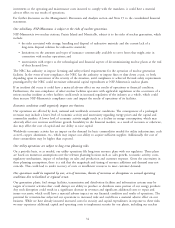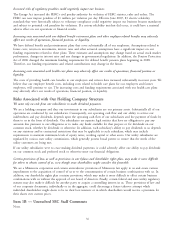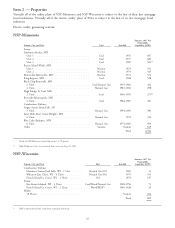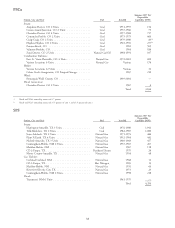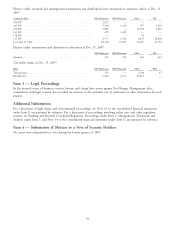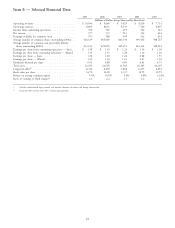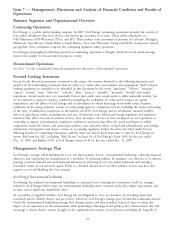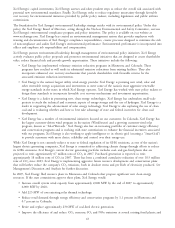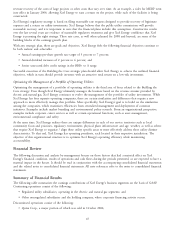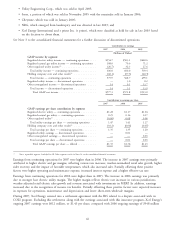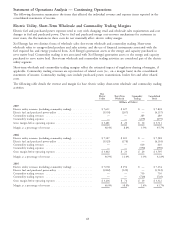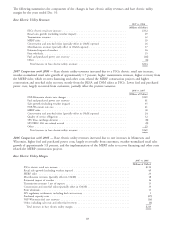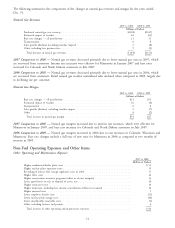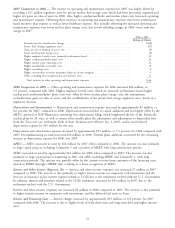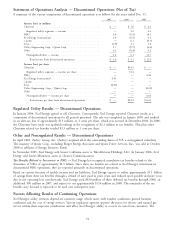Xcel Energy 2007 Annual Report Download - page 54
Download and view the complete annual report
Please find page 54 of the 2007 Xcel Energy annual report below. You can navigate through the pages in the report by either clicking on the pages listed below, or by using the keyword search tool below to find specific information within the annual report.• Upgrade the efficiency and capacity of existing nuclear facilities.
Xcel Energy has designed these plans so that, depending on fuel, commodity and other assumptions, Xcel Energy
would maintain a reasonably priced product and continue to provide reliable power to our customers. At the same
time, if approved, the plans would result in a significant reduction in CO2 emissions. The proposed Minnesota plan
would reduce NSP-Minnesota’s CO2 emissions by 22 percent below 2005 levels by 2020. The proposed Colorado plan
would reduce PSCo’s CO2 emissions by 10 percent below 2005 levels by 2017 and position PSCo to propose additional
reductions to achieve a 20 percent reduction by 2020.
Our environmental leadership strategy has resulted in numerous environmental awards and recognition. For example,
Xcel Energy was named to the Dow Jones Sustainability Index for North America for 2007-2008, the second
consecutive year that Xcel Energy has earned this distinction. Xcel Energy strives to provide the public with detailed
information regarding environmental performance and risk. Among other things, our utility companies operating in
Minnesota, Colorado, and New Mexico use a carbon proxy cost mandated by the state commissions to evaluate the
impact of potential future CO2 regulation on its future resource acquisition plans. Xcel Energy publishes a Triple
Bottom Line Report annually, which is available on our website, www.xcelenergy.com. The Triple Bottom Line report
discloses Xcel Energy’s environmental, economic and social performance. Xcel Energy also provides detailed information
to environmental research organizations, such as Trucost, the Carbon Disclosure Project and the Climate Registry.
Achieving Financial Objectives
Xcel Energy’s financial objectives of Building the Core also has three phases: obtaining legislative and regulatory support
for large investment initiatives, investing in the utility business and earning a fair return on utility system investments.
The first phase, as noted above, is obtaining legislative and regulatory support for large investment initiatives, prior to
making the investment. To avoid excessive risk to Xcel Energy, it is critical that Xcel Energy reduce regulatory
uncertainty before making large capital investments. Xcel Energy has accomplished this for both the MERP in
Minnesota and the Comanche 3 coal unit in Colorado. Transmission legislation has been passed in Minnesota,
Colorado, Texas and several other jurisdictions where Xcel Energy operates.
The second phase is investing in the utility business. In addition to Xcel Energy’s normal level of capital investment,
Xcel Energy expects to have significant investment opportunity, in part attributable to the environmental strategy
described above. Those opportunities include the following:
• Approximately $1 billion through 2010 for MERP, a project to convert an aging coal-fired plant to a natural gas
plant and to install pollution control at another plant. During 2007, the initial phase of this project was
completed with the successful conversion of the Allen S. King plant to a natural gas facility;
• Approximately $1 billion through 2010 for Comanche 3, a project to build an additional coal unit in Colorado;
• Approximately $215 million for the planned addition of two gas fired units totaling 300 MW at the
Fort St. Vrain generating facility located in Colorado;
• A proposed $1 billion investment through 2015 to extend the lives and increase the output of two nuclear
facilities, Monticello and Prairie Island;
• A proposed $1.1 billion investment through 2015 to add capacity and reduce emissions at the Sherco coal fired
plant;
• A planned investment by the CapX 2020 coalition of utilities ranging from $1.3 billion to 1.6 billion between
2008 and 2015 to expand the transmission system in the upper Midwest, of which Xcel Energy’s share of the
investment would be approximately $700 million, representing the first phase of CapX 2020; and
• Several other potential environmental initiatives, including substantial wind generation investment described
above and outlined in the recently proposed Colorado and Minnesota resource plans.
As a result of these investments, as well as continued investments in the transmission and distribution system, Xcel
Energy expects that the rate base, or the amount on which Xcel Energy earns a return, will grow on average annually
by more than seven percent from 2006 through 2011.
The third phase is earning a fair return on utility system investments. To this end, the regulatory strategy is to receive
regulatory approval for rate riders as well as general rate cases. A rate rider is a mechanism that allows recovery of
certain costs and returns on investments without the costs and delays of filing a rate case. These riders allow for timely
44


